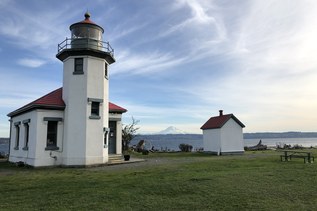The North Fork Sol Duc River is a remote wilderness trail teeming with adventure. The trail is seldom maintained all the way to its end, and three river fords complicate the effort. The shoulder season hiker may experience solitude and wildlife, but they will also likely encounter high water, blowdown, and route-finding challenges.
The trail starts on the north side of the Sol Duc Road at a signpost and permit box. Ascend gradually through sparsely-spaced hemlock and some old fir, a result of a fire that swept this side of the ridge about two centuries ago. Sword fern and vanilla leaf compose the understory, and the broad slope has an open view through the forest.
At a half-mile the trail crests a low ridge top and descends toward a mossy ravine filled with devils club. One giant Douglas-fir stands defiantly above the ravine, its crown spreading two hundred feet above the ground. The trail then descends toward a spruce bottom that resembles a miniature version of the famed Olympic rain forests.
At 1.0 mile the trail reaches the bank of the North Fork Sol Duc River. This is the first of three fords along the course to the shelter at the trail’s end. The best place to ford is usually just downstream from the trail. Once on the other side of the river the valley opens up into a broad flat showcasing Sitka spruce and bigleaf maples festooned with mosses and licorice fern.
At 1.4 miles the trail skirts a rocky bank next to a series of scenic pools and cascades. The view upriver is wild, with forested ridges reaching thousands of feet and disappearing into clouds most days of the year. The trail then ascends uphill into a mix of hemlock and fir on good tread. The thundering river can be heard below, although it is out of sight.
At 2.3 miles the trail descends to another grassy flat, then gains a short uphill section to another flat full of stately hemlock. Two campsites appear on the right; the first one is large and somewhat away from the trail, the second site is smaller and almost on the trail, but with a nice view over the river. Several large, moss covered boulders decorate this final flat.
At 3.3 miles the trail climbs uphill and switches back to a bench high above the river. Several side streams may present tricky crossings early in the season. Old-growth Douglas-fir and hemlock now tower overhead, creating a cushy layer of cones and needles on the trail. At one point the trail becomes a grand promenade through a hall of large, cut logs. The hiker may marvel at the effort to cut this section of trail through the masses of blowdown.
An eventual descent to the river leads the hiker to the second ford at 6.3 miles. This may be a good turnaround point for day hikers since the last few miles are usually unmaintained, brushy, and sometimes washed out.
Otherwise, press on. Once on the other side of the river, now a tributary of the North Fork, the trail immediately climbs via one long switchback to a high traverse of the canyon.
Gone now are the wide valley bottoms. Here the mountains pinch the river into a true canyon below the south face of Aurora Ridge. A steep meadow can be seen high on Aurora Peak. Soon the river is visible again, meandering about its gravel bars and log jams, until the trail drops to its bank at 7.8 miles.
The trail now enters the deluge of the river bed. Cut logs indicate where the trail is located, and flagging or arrows may also be present. This is the third and final ford. The trail now enters its last mile on the east side of the East Branch of the North Fork. The shelter stands at 9.0 miles and boasts its status on the National Register of Historic Places. Refurbished in the late 1990s, the shelter offers a dry night for those willing to camp among rodents. A site for tents and a nice privy make for a pleasant place to stay.






 Trailhead
Trailhead



